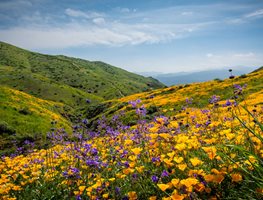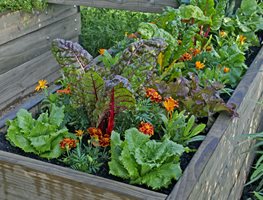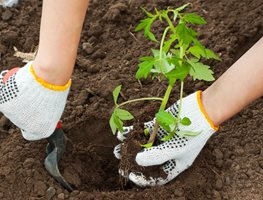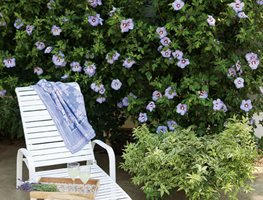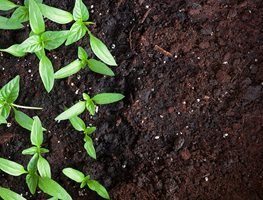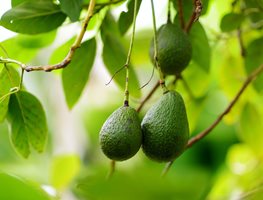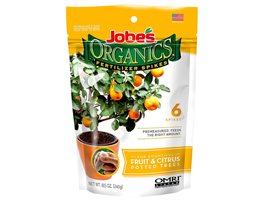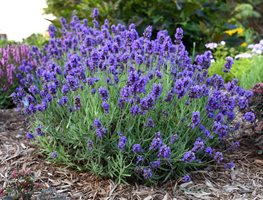10 Gardening Activities for March in Southern California
Here are a few garden reminders, inspiring ideas, and maintenance suggestions for this month.
1. Tour Native Plant Gardens
The Theodore Payne Native Plant Garden Tour is held toward the end of March. Be sure to get your tickets to see these beautiful gardens throughout Los Angeles county. Typically, tour goers visit 5 to 7 gardens per day, which provides ample time to enjoy each garden, observe plants and wildlife, and stop for lunch. The gardens are open for 2 days from 10 am to 5 pm. If you can’t make the tour there are other great public gardens to visit that showcase native and Mediterranean plants: Santa Barbara Botanic Garden, Rancho Santa Ana Botanic Garden, Los Angeles Arboretum, and The Huntington. See more about area gardens in our Self-Guided Day Trip for Los Angeles.
2. Plan to Go Wildflower Watching
In years where Southern and Central California get late fall and early winter rains, there’s a chance that wildflowers will be bursting into bloom from March through July in the High Sierras. Plan your trip (or a few trips!) now. The OC Register has a great summary of various wildflower-watching spots to help you decide when and where to go (The article may be from the past but the list is useful still.). You can also stay up-to-date on how the wildflower season is progressing using the Theodore Payne Wildflower Hotline.
3. Plant Flowers in Your Kitchen Gardens
When planning your kitchen garden be sure to include an abundance of flowers in your plan. Not only are the flowers beautiful and useful for those spring and summer arrangements, but they also attract pollinators and beneficial insects. The pollinators will help increase the production of edible and beneficial insects, which will help keep pest issues such as aphids, hornworms, and mealy bugs under control. Plant flowers such as asters, coneflowers, coreopsis, goldenrod, marigolds, yarrow, and zinnias.
4. Transplant Warm-Season Crops
For many of the most populated areas of Southern California, the average last frost date is shortly before the end of March. For some cities, frost is rare; and in other cities, the last frost date may have passed back in February. From the end of March through April, you’ll want to transplant warm-season crops. Be sure to harden off starts before transplanting them. This means moving the starts outdoors for progressively longer periods over a 7- to 10-day window. During this time, keep plants out of direct sunlight as well as excessive heat and wind. Hardening off helps plants acclimate to outdoor growing conditions. If you didn’t plant starts indoors, buy them at a local garden center or start your plants now (many varieties will be ready to transplant in 6 to 8 weeks).
5. Plant Tropicals
Since much of Southern California has mild winters with little to no frost, growing tropical plants is a great way to fill your garden with dramatic foliage and vibrantly colored flowers. Consider planting tropicals such as elephant ear or banana for their large foliage, hibiscus for its oversized colorful flowers, pineapple guava for its edible fruit and flowers, bromeliad for their foliage and flowers, or plumeria for their floral fragrance. A few other tropicals to consider include angel’s trumpet, cordyline, bird of paradise, and palms. Search for tropical plants at your local nursery or at online retailers such as Proven Winners, Logee's, or Plants Express.
Don't miss what to do in the garden each month, make sure you're getting our weekly newsletter.
6. Give Your Soil a Spring Boost
As spring begins, many plants begin their growth cycle which includes foliar or woody growth. This type of growth demands nutrients, especially nitrogen. Cover your garden beds with a layer of organic compost or fertilizer to ensure plants are well fed to begin the season. Keep compost or fertilizer away from tree or shrub trunks or plant stems because it can cause rot or other pest issue.
7. Prune Avocado Trees
Generally, the avocado harvest is complete by March so it’s a good time to prune back trees. They do not require pruning, but it’s good to prune for overall shape and tree health. Remove any dead or diseased branches, as well as those that may have been scorched. Pruning trees also forms a strong, balanced, interior branching structure. If one limb gets too big it can break during the fruiting season with the added weight from maturing fruit.
8. Fertilize Citrus & Protect Trees from Pests
As the growing season begins, fertilize your citrus with a citrus fertilizer. Fertilization can be done monthly through July. Follow the application directions on the package of any fertilizer you apply. When fertilizing your citrus, look for any pest issues or dead branches. If ants are present in great numbers then you likely have a pest issue such as mealybugs, aphids, soft scales, or whiteflies. Ants feed on the honeydew these pests excrete. If you identify any pest issues, read up on removing pests naturally. Help prevent pest issues and ants by skirting the tree branches (removing low-hanging branches) at 12 to 30 inches off the ground. There are also sticky substances (Tree Tanglefoot) that you can put around your tree trunk to stop insects from getting into the tree.
9. Feed & Cut Back Ornamental Grasses
If you haven’t cut back ornamental grasses yet, then do so now. Grasses will spring back with new growth quickly. After cutting your grasses back, feed them with a nitrogen-rich fertilizer or apply a generous layer (2 to 3 inches) of compost around plantings. Spring can also be a good time to plant grasses if you didn’t do so in the fall. A few particularly good selections include 'All' Gold Japanese Hakone grass (if you have shade), 'Karl Foerster' feather reed grass, 'Apache Rose' switch grass, and 'Blonde Ambition' blue grama grass.
10. Plant Perennials
March is prime planting season for perennials in Southern California. Plant now through April and even early May. Consider planting a mix of waterwise, adaptable perennials such as lavender, ceanothus, manzanita, hummingbird sage, Cleveland sage, Mexican sage, rock rose, kangaroo paw, succulents, lomandra, ornamental grasses, iris, lantanas, agapanthus, buckwheat, and monkey flower. You can find many of these plants at local nurseries or online at retailers such as Proven Winners.
If you enjoyed this information, sign up for our weekly newsletter. Each week, you'll get Garden Design's best delivered right to your inbox including design tips, plant picks, great gardens, outdoor living products, and events to enjoy — along with monthly gardening checklists just for your area.
Do you know someone who would enjoy this Southern California Region gardening information? Why not share it with them?
When you purchase products through links on our site, we may receive an affiliate commission. Thank you for your support.

